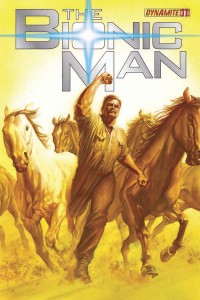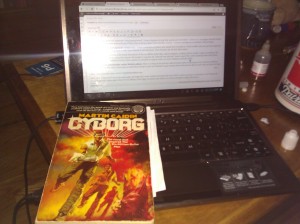 When I was six or seven years old, I had a Power Records LP…
When I was six or seven years old, I had a Power Records LP…
(Note to Generation Y: “LP” stands for “long playing record.” It was a big piece of vinyl that sounds were recorded on. Think a CD, only bigger and with shittier sound, no matter what line of horseshit Jack White tries to sell you about vinyl sounding “warmer.” Crackles and skips are not features, they are bugs,)
(Note to Millennials: “CD” stands for “compact disc.” It was a small piece of plastic that sounds were recorded on. Think an MP3, only one you had to spend all your beer money on in college back in 1991 if you wanted to own any music. Now all of you: get the fuck off my lawn.)
Sorry about that. Anyhoo, I had the Power Records LP of The Six Million Dollar Man, which included a retelling of Steve Austin’s origin, according to the television series. Which is a story that anyone old enough to associate the “bah-nah-nah-nah-nah” bionic sound effect with something other than Chevy Chase doing putts in Caddyshack knows: Steve Austin is a test pilot in a plane crash, and Oscar Goldman and Rudy Wells…
(Note to Gen X’ers and drunken comics Website editors: There is a thing on the Internet called YouTube where everything you ever loved as a child has been collected, for free. And it allows you to embed those things in your own Website! So quit chasing those little bastards off your lawn and, you know, do that,)
 Okay, so now that we’re all on the same page, the thing that I never understood about this story when I read it as a boy, or even when I read Cyborg, the novel by Martin Caidin upon which The Six Million Dollar Man was based (and which I re-read on the plane to SDCC this year. Toldja I was a Six Million Dollar Man fan), was why Austin was initially so angry about being kept alive with the bionics. The man went to sleep in an airplane and woke up with fucking superpowers; when I fall asleep on an airplane, I wake up with a runner of drool connecting the corner of my mouth and the shoulder of the poor bastard sitting next to me, and maybe with a nicotine fit.
Okay, so now that we’re all on the same page, the thing that I never understood about this story when I read it as a boy, or even when I read Cyborg, the novel by Martin Caidin upon which The Six Million Dollar Man was based (and which I re-read on the plane to SDCC this year. Toldja I was a Six Million Dollar Man fan), was why Austin was initially so angry about being kept alive with the bionics. The man went to sleep in an airplane and woke up with fucking superpowers; when I fall asleep on an airplane, I wake up with a runner of drool connecting the corner of my mouth and the shoulder of the poor bastard sitting next to me, and maybe with a nicotine fit.
It wasn’t until I was older that I could get my head around the idea that having most of yourself replaced – even if the replacements were better, stronger and faster – might take away your image of yourself, and that transition might take some time, if not forever, to come to terms with. But that coming to terms is a huge part of Steve Austin’s story. Even though I didn’t fully understand that as a child, I grasped it instinctually; to this day, even before I found that YouTube video, I remembered the poor bastard whose resume reads, “Voice double for Lee Majors on childrens’ record” saying, “I’m not a man anymore… I’m a freak,” including that wretched music cut cue that would make the worst twelve-year-old Skrillex wanna-be hang his head in audio editing shame.
All of which is one hell of a long way to go to say that The Bionic Man #11 is a pretty good story about Steve Austin reuniting with his dying father that has a lot of compelling human moments to make it a good read… but which misses a huge opportunity by leaving all Austin’s confusion and self-pity over his resurrection unused on the table.
Written by Phil Hester, this is the first issue that deviates from Kevin Smith’s original screenplay for The Six Million Dollar Man, and has Austin returning to his childhood ranch to reunite with his family, who has thought him dead since the plane crash. He arrives to find his father on an oxygen tank with a short and shitty prognosis, and he spends the issue trying to reconnect with the old man. And there is a lot to like in this story; Hester shows us a lot without telling us about a father trying like hell to hand on and give a brave front to Austin, as he suffers through the end stages of something bad. The poor prick’s on oxygen, his bladder control is shot, and he is clearly in terrible pain and fighting to not show it – there’s a bit of business where Hester shows the old man’s hospice nurse saying that his new pain medication will constipate him, which screams “morphine” to anyone who’s seen Trainspotting or done morphine (no comment) that I found more effective at communicating how dire the situation is than even seeing the guy piss his pants.
This is a very human story about grief, coming to terms with loss, and the tough idea that sometimes you just can’t say goodbye on your own terms if you want the person you’re saying goodbye to to be remotely content. It also has Bigfoot.
But what it doesn’t have is any kind off tension arising from the fact that Austin himself was on death’s door nine issues ago and was not only saved, but improved. It doesn’t pull any conflict out of the concept that Austin clearly has access to doctors who can perform bionic miracles on the dying, and whether he could, or should, try to use those to save his dad – in fact, the story goes out of its way to make sure his father doesn’t learn about Austin’s bionics… but I’m surprised his mother, who does learn, doesn’t even mention it or apparently even think of it. It doesn’t address Austin’s self-pity over his bodily mangling and contrast that with the decrepitude of his father.
I generally try not to review books based on what’s not there, or what I wished was there, because it’s not really fair to the writer. And this is not a bad story because of those omissions, make no mistake; I found it to be genuinely touching, with some serious darkness around dealing with the death of a parent that you wouldn’t normally find in a comic book. But considering that Austin’s difficulty coming to terms with the engineering miracle that saved his life is such a huge part of his character regardless of the media in which he is portrayed, not bringing that into play when faced with a situation where a loved one is clearly and imminently doomed seems like a big missed opportunity to me.
I found the art by Ed Tadeo to be generally very impressive, in a somewhat 90s style kind of way. Most of his figures are realistic, with varying body types that make sense considering this is a family story rather than a straight-up superhero action story. Austin’s father is shown as disturbingly frail, and his sister looks like an actual woman who knows what a sandwich is. The guy can even draw horses, which isn’t something that most superhero artists seem to do all that well. His panel layouts are clear and unambiguous, and his facial expressions are generally pretty clear. I only have tow complaints about the visuals: the guy does 90s-style fine details lines about 90 percent too often. As I’ve said before about other artists with similar styles, if every line adds five years to a character’s face, then there are times in this book when Steve Austin is 927 years old. In addition, Tadeo shows Austin as jacked. Like, Liefeld jacked. Like, a leg pouch and 224 teeth away from being Cable jacked. It’s not awful, but it really stands out considering how well and varied he draws all the other human characters in the book.
All in all, as a comic fan, I really enjoyed this book. It is a well-executed, small scale human story of the type you don’t often get in an adventure comic. But as a Six Million Dollar Man, fan, I think it just leaves too many obvious character traits on the table to be a truly successful Steve Austin story. However, coming off the big climax of Kevin Smith’s opening arc, it is an excellent character-driven story to cleanse the palate and engage us with Hester’s version of Steve Austin before having the character fight Bigfoot.
No, I wasn’t kidding.
 Podcast RSS Feed
Podcast RSS Feed iTunes
iTunes Google Play
Google Play Stitcher
Stitcher TuneIn Radio
TuneIn Radio Android
Android Miro Media Player
Miro Media Player Comics Podcast Network
Comics Podcast Network